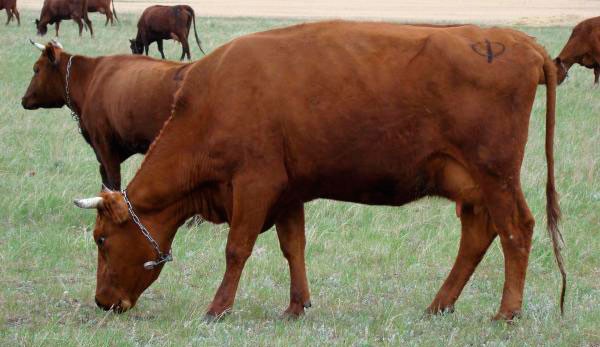Type the name of the breed you're looking for below
[wpdreams_ajaxsearchlite] Don't see the breed your're looking for? Click here and let us know!
Latvian Brown cattle
| Place of Origin | Latvia |
| Origin | The breed began to be formed in the middle of the last century when Angeln cattle were imported into Latvia to improve the local, low-productive cattle. The crosses had a higher milk yield but lower fat content. At the end of the last and early in this century Danish Red bulls were imported and used on the Angeln crosses and on the local cattle. The long-term breeding of the crosses inter se with systematic selection for milk yield and fat content ensured the development of highly productive cattle. Since 1885 the best animals were registered and the first herdbook was published in 1911. In 1947 the breed was given a new name - Red-Brown Latvian. By 1980 numbers had reached 1 417 000 head. These cattle vary in color from light-red to dark-red. The head, neck and legs are often darker. They have a strong constitution. The head is small, light and moderately long. The skeleton is light, chest deep, body long, rump slightly raised, udder usually well developed. |
| Purpose | Meat and dairy. |
| Appearance | These cattle vary in colour from light-red to dark-red. |
| Horns | Small horns. |
| Cows Average Weight | 525 to 600 kg (1150 - 1350 pounds) |
| Bulls Average Weight | 750 - 850 kg (1653 - 1874 lbs.) |
| Other Considerations | The milk yield of purebred Latvian Brown cows is high. The average milk yield of the mature cows recorded in Volume 29 of the Herdbook (1983) in their best lactation was 4537 kg and the fat content 4.28%. The average yields of the nearest female ancestors of the bulls recorded in Volume 29 of the National Herdbook were 5970-6036 kg of milk and the fat content was in the range 4.38-4.73%. The champion milk producers are: Nadze 8977 - 8457 kg milk with 3.93% fat; Yetse 6320 - 8170 kg, 4.21%; Grieta 4915 - 8113 kg, 4.26%; Roya 5212 - 8021 kg, 4.10%. As a genetic resource for Latvia, Latvian Brown cattle are of primary importance: they account for 99% of all cattle in this country. The breed includes 4 major lines. in the improvement of Latvian Brown cattle much importance has been attached to line breeding. In 1979 a new breeding line was tested and approved; it was named BL-1 (Brown Latvian No. 1). The number of the BL-1 line is over 50,000 head. This line is being developed in four branches by the assortative mating of sires to cows from the best families and by periodical moderate inbreeding. The major selection herds belong to the breeding centers Vetsautse, Sigulda and Sarkanais Octobris. The BL-1 cows are noted for their harmonious conformation. The udder is large, glandular, usually cup-shaped or spherical with equally developed quarters (average index is 45%). The milk yield of the cows in the selection group is 5287 kg; fat content averages 4.16%, and protein content 3.45%. There are many champions in this line; they combine high yield with increased fat content: Undra 6088 - 4th lactation, 9298 kg milk, 4.75% fat, 3.84% protein: Baka 3469 - 4th, 8544, 4.82%, 4.05%; Dalasa 4044 - 8th, 10 106, 3.76%. The Latvian Brown breed of cattle is being improved with the aim of increasing milk yields to 5000 kg with the same fat and protein content and to meet the requirements of the industrial methods of cattle management |



